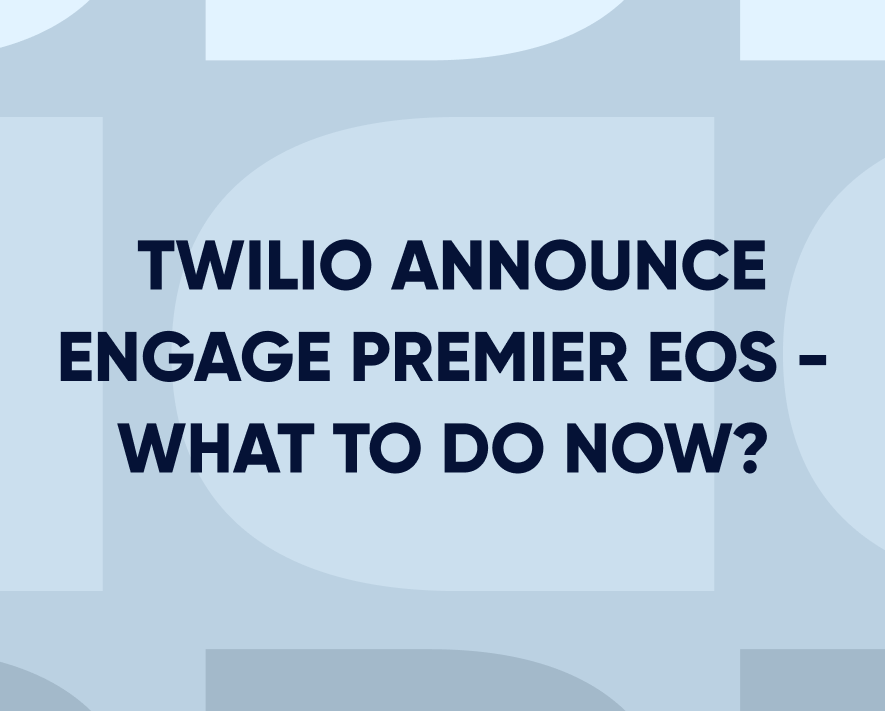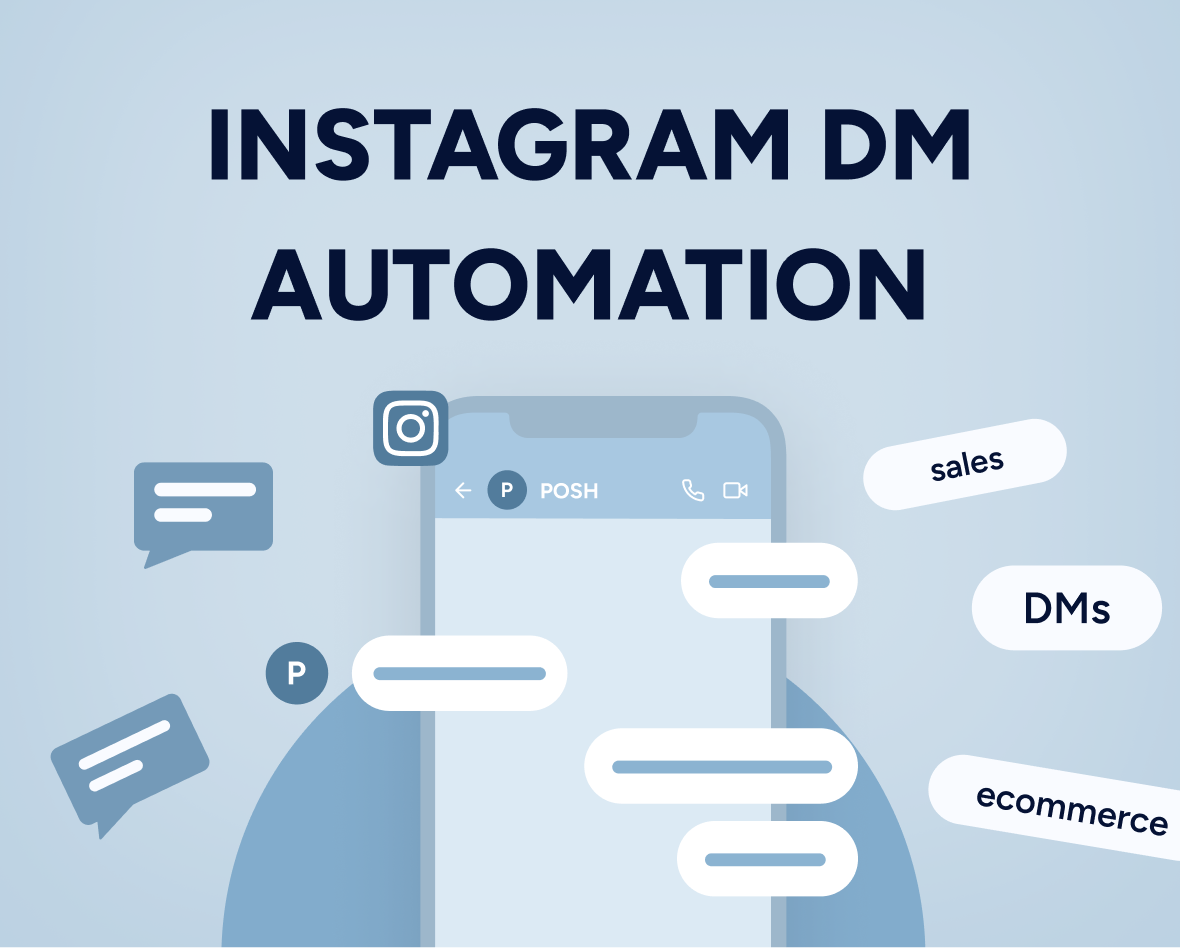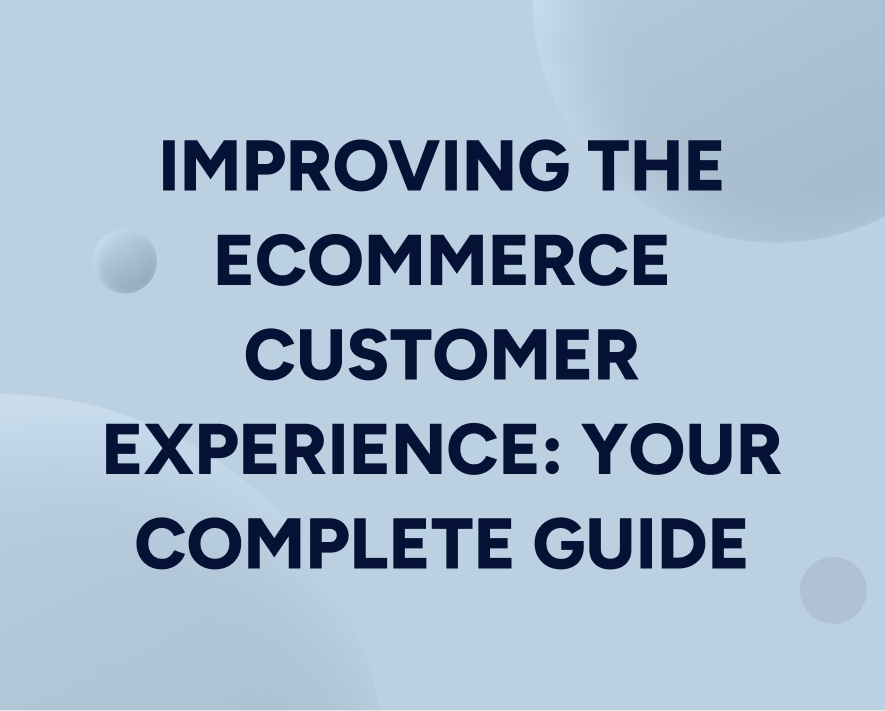Cross-Channel Marketing 101: Everything You Need to Know
Today’s consumers are more aware of their shopping behaviors and expectations than ever before. They have specific demands for the price, ingredients, delivery options, production methods, customer experience, and so much more. They also expect a seamless experience from online to offline and vice versa.
That’s why multichannel marketing no longer works. Marketers need another strategy that helps meet customers where they are and fulfill their expectations while achieving sales goals.
Enter cross-channel marketing.
In this article, we’ll tell you everything you need to know about cross-channel marketing, including what it is, how it benefits your business, which steps you can take to implement it, and the challenges you might face along the way. We’ll also provide practical use cases of cross-channel marketing to inspire you to get started. It’s time to level up your cross-channel marketing campaigns…
Updated on 17 May 2024
Before we dive into the details of cross-channel digital marketing, let’s find out why multichannel marketing is no longer effective.
Why Multichannel Marketing Is No Longer Enough
Multichannel marketing means using a variety of marketing channels to connect and engage with customers. However, these channels work independently from each other, which means they don’t provide a seamless or connected user experience.
The main reason why multichannel marketing is no longer an effective marketing strategy is that modern consumers’ shopping behaviors have fundamentally changed. Today’s consumers may see a Facebook ad, follow your brand on Instagram, visit your online store, read reviews, subscribe to your newsletter, and more. They may go through seven or more touchpoints before they’re finally ready to make their first purchase.
And if all of these touchpoints aren’t joined up and working together, how are you supposed to provide a seamless experience? This is why having a cross-channel marketing strategy is so important for brands.
Consistency and relevancy count
To nurture customers effectively, your branding and messaging must be consistent across all of your different channels. Your customers need to have the same impression of your brand wherever they find you—whether on your Instagram page or via an ad on Google. This cross-channel marketing approach helps to build brand consistency and awareness, plus ensures the customer knows just what to expect from your brand which helps to build trust.
And consistency, trust, and personalization are impeccably important in today’s world. SmarterHQ’s study found that 70% of millennials are frustrated by brands that send irrelevant emails, and 72% of consumers say they only engage with personalized messaging. What’s more, 91% of consumers are more likely to shop with brands that provide recommendations that are relevant to them, according to Accenture.
What Does Cross-Channel Marketing Strategy Really Mean?
According to Oracle, cross-channel marketing “employs multiple, connected channels to reach customers. This allows for an easier and more seamless transition from channel to channel. The different channels record information about the customer and communicate it between each other, so they can all come together into a single, consistent customer journey.”
For instance, when you practice cross-channel marketing, your messages and branding are consistent across multiple channels. This variety of channels works well together, which effectively engages and supports customers as they move across touchpoints and devices in the buyer’s journey.
Benefits of Cross-Channel Marketing
An efficient and intentional cross-channel marketing strategy brings many benefits to your business. Let’s take a look at some of these benefits below.
- Build trust and brand awareness through consistent messaging. This is critically important given that consistent brand presentation across all platforms was found to increase revenue by up to 23% (Marq).
- Gain a rich and detailed picture of customer behaviors through reporting and cross-channel marketing analysis. You can see what channels customers prefer, what content caused them to convert, and where they might have dropped off.
- Maximize your marketing ROI and boost growth. By integrating your marketing efforts across channels, you can map out touchpoints to see how someone went from a lead to a customer. You can then contextualize and personalize the message and offer it to your target customers on each channel.
- Leverage all of this customer data to create relevant and hyper-personalized experiences for each individual. When you give customers exactly what they want, you delight them, and a delighted customer is a loyal customer. They’ll keep coming back and spreading the word about your brands, don’t underestimate the word-of-mouth. In addition, consider implementing real-time marketing strategies to further enhance customer engagement and responsiveness.
- Cross-channel marketing software does the hard work of aggregating data and reports for you, leaving you free to focus on scaling up your marketing strategy and delivering results.
Challenges of Cross-Channel Marketing
Investing in cross-channel marketing can help you quickly take your business to the next level. Still, it can also come with challenges you need to keep in mind.
Firstly, you can only provide personalized messages and recommendations when you have a complete 360-degree view of each customer. To do this, you need to collect customer data from multiple disparate sources (such as your online store, email platform, social media, physical locations, and mobile apps) and turn this data into actionable insights.
Secondly, you need the right cross-channel marketing technology. Typically, it can take six to ten different tools for a brand to deliver integrated experiences. But as your tech stack grows, so does the complexity, cost, vulnerability, and inefficiency of your marketing campaigns. You need to define your goals, budget, and strategy from the get-go to figure out which tools you need.
Tools like Insider’s advanced cross-channel marketing platform enable you to consolidate your multiple tools into one simple-to-use platform. Insider stitches together every customer interaction into a clear picture of offline and online behaviors, revealing each customer’s interests, needs, and preferred touchpoints. With cross-channel campaign management, you’re free to build the cohesive, frictionless experience that your customers expect.
Insider’s 8-Step Guide to Creating a Cross-Channel Marketing Strategy
Step 1: Unify Your Data
Accurate data is key. The first step in building a successful cross-channel marketing strategy is to work on data quality to better understand your customer and build an accurate picture of their experience. A good way to ensure accurate data is with an all-in-one marketing solution like Insider, which provides a multitude of data points and helps you form a unified view of each and every customer (even the anonymous ones!).
Step 2: Create Customer Segments
Once you have the data, segment your target audience by demographic, psychographic, geography, and behavior. Doing this will help you understand key nuances between similar customer types, enabling you to tailor your messaging and product offerings specifically to them.
Step 3: Define And Choose Your Best Channels
List the various channels your customers can commonly be found on. For example, if they often visit your online store, you can use web push and onsite personalization within your cross-channel marketing strategy to target them. If your customers shop online on mobile, use app push notifications, email marketing, or RCS messaging to connect with them.
If your customer visits your offline store, you can utilize offline marketing elements like OOH advertisements, QR Codes, flyers, etc. With the help of the best QR Code generator, you can create QR Codes to help you get the most out of your offline marketing campaigns.
Step 4: Start With Micro Funnels
When you get started with cross-channel marketing, try to create and optimize your micro funnels first. An excellent example of a micro funnel is launching a cart abandonment cross-channel marketing campaign — doing this will help you find out issues in your broader marketing funnel and fix them right away.
Step 5: Test Different Types of Journeys and Channels
Take advantage of A/B testing and multivariate testing to see what your customers’ cross-channel journeys look like, where they hang out, and what elements of cross-channel campaigns they respond to. Then tweak, improve, and optimize your campaigns accordingly.
Step 6: Once Proven; Scale
Once you determine which cross-channel campaigns bring you the best results, run them to all of your existing customers and new ones. Using Insider’s cross-channel marketing platform makes this easy by letting you duplicate and edit campaigns, and then target them to new audiences.
Step 7: Monitor and Analyze Performance
One of the most important parts of any strategy is cross-channel marketing analysis. Use metrics and data analytics tools like Google Analytics to analyze and monitor your campaigns’ performance. Doing this will help you find out what works and what doesn’t— plus provides valuable insights for your future marketing campaigns.
Step 8: Iterate and Start Again
When you have essential pieces in place, repeat the above steps to improve your cross-channel marketing strategy performance further. Return to them, again and again, to see what you can learn and tweak to deliver even better results.
Cross-Channel Marketing Examples
You can apply cross-channel marketing to engage and convert first-time visitors, boost retention rates, drive referrals, or reactivate silent customers. Below, we cover four practical examples of cross-channel marketing in a little more detail.
1. For Acquiring New Users
Imagine you’re a fashion retailer. When someone visits your online store for the first time, they don’t know what dress to choose, so they leave your website without buying anything.
With a cross-channel marketing strategy in place, you could ask them if they’d like to receive web push notifications about new stock arrivals via desktop or mobile web. You could also offer them a discount in exchange for their email address, which you can use to run retargeting campaigns via email later. Remember to verify if the emails you got are correct by using an email verification tool.
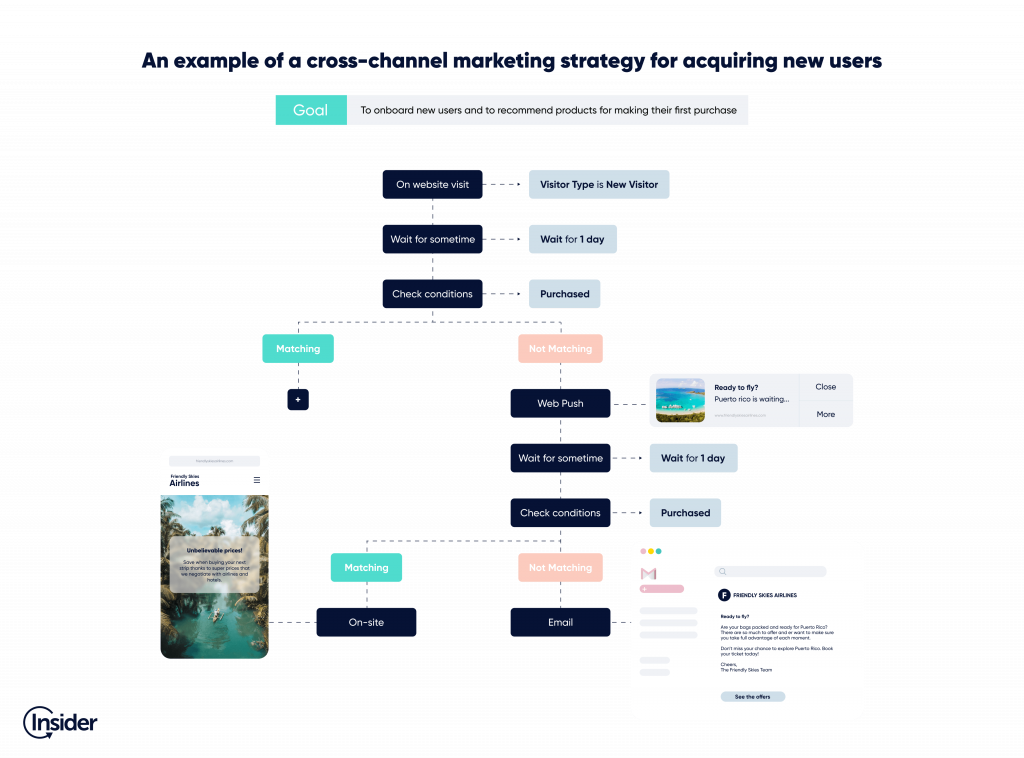
2. For Reducing Cart Abandonment
Cross-channel marketing campaigns are great for reducing cart abandonment. Say someone adds something to their cart on your website and then leaves. By using a cross-channel marketing platform like Insider, you can create an abandoned cart flow that runs retargeting social media campaigns or shows reminder pop-ups on your website. You can also send web push notifications and SMS messages to remind visitors what they left in their cart and encourage them to purchase.
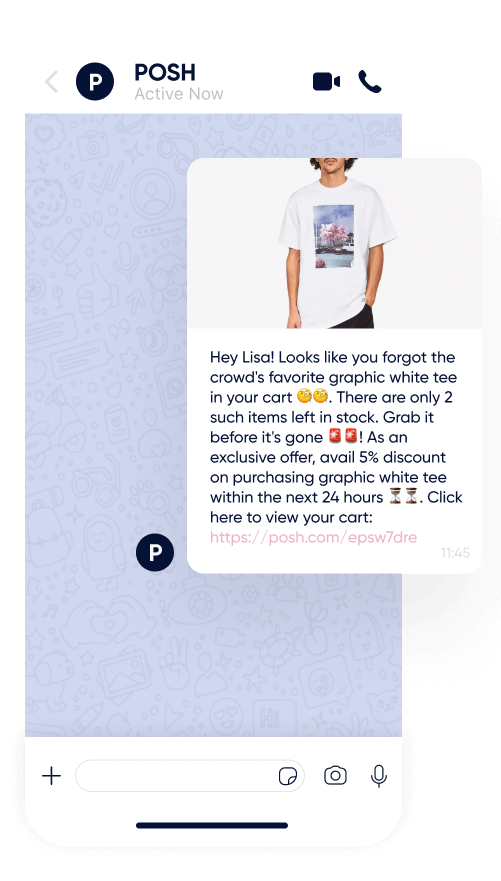
3. For Cross-Selling and Upselling
Upselling and cross-selling products are clever strategies for increasing customer loyalty and boosting average order value (AOV). You can offer upsells and cross-sells via email marketing, Facebook ads, SMS messages, or showing them on product detail pages.
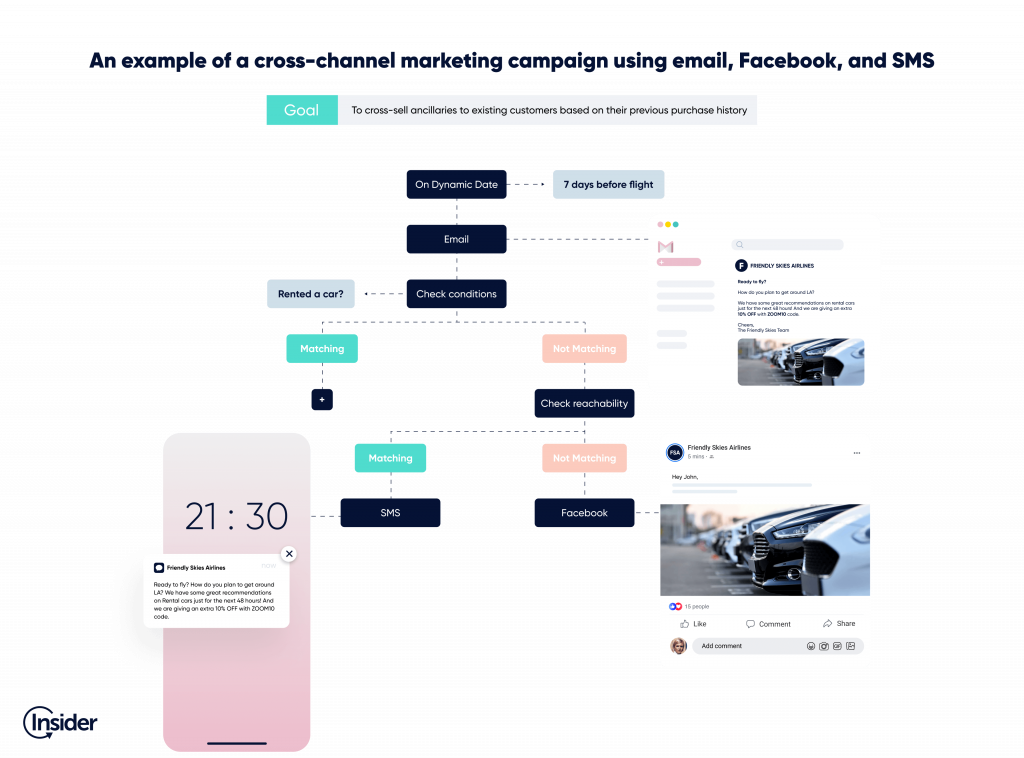
4. For Re-Engaging Silent Customers
How often do customers purchase a product and then fall silent? Then why not run cross-channel marketing campaigns to encourage them to come back? You could send them a personalized discount via email, alert them to flash sales via web push notifications or run retargeting Facebook ads.
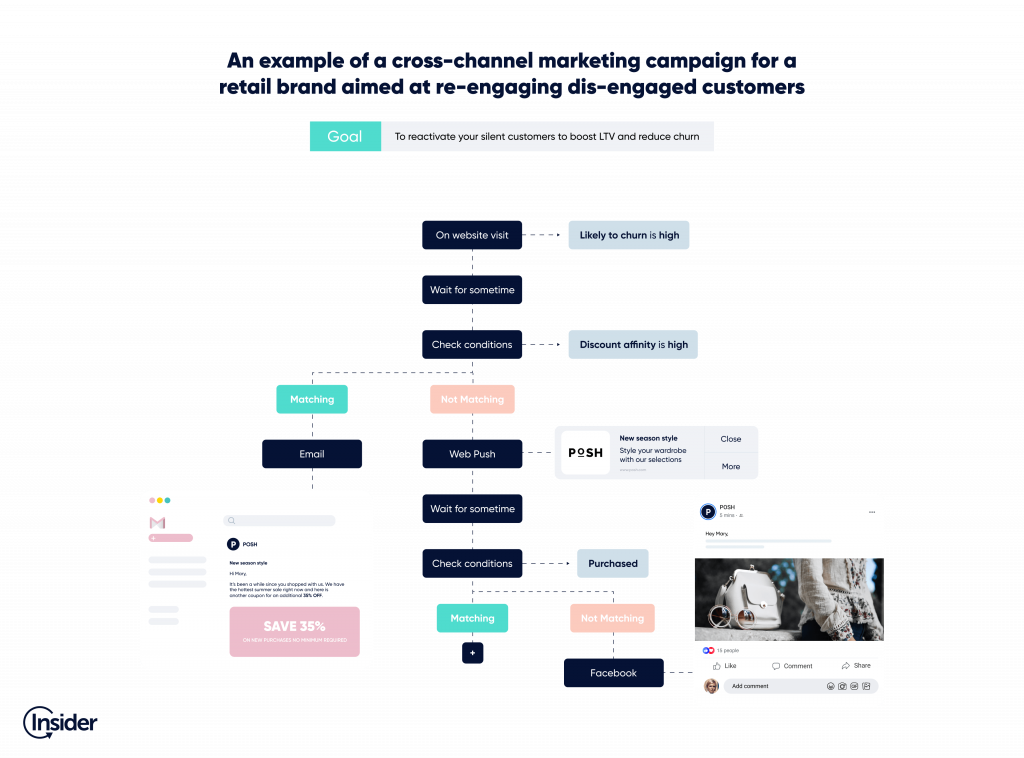
See for yourself
In this demo, we show you how to leverage Insider’s Architect tool to create hyper-personalized cross-channel journeys to drive engagement, conversion, and loyalty.
Ready to Implement Cross-Channel Marketing for Your Business?
A successful cross-channel marketing strategy helps you convert modern shoppers by reaching them in the right place at the right time. That said, executing cross-channel marketing campaigns efficiently requires integrating several areas of marketing and customer engagement, including data and insights, customer experience strategy, and customer segmentation.
You also need the right cross-channel marketing technology to ensure accurate implementation across all channels. And that’s where Insider comes in. We were recently recognized as a Leader in The Forrester Wave™: Cross-Channel Campaign Management (Independent Platforms) research piece.
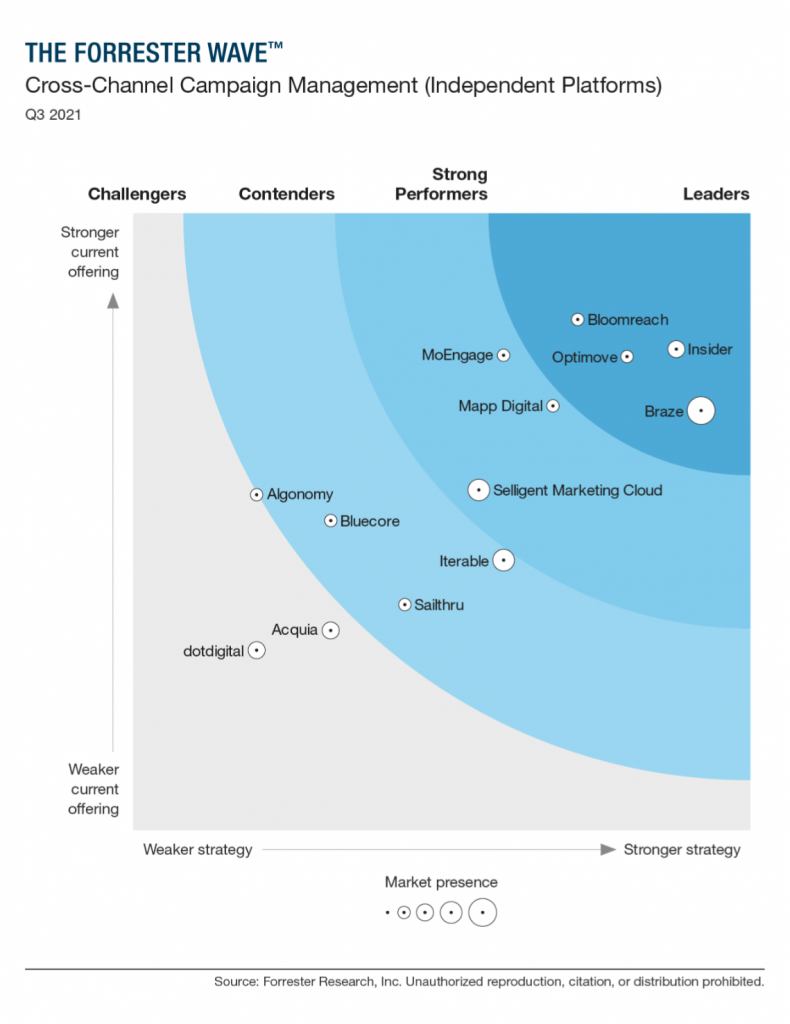
Book a demo
We hope this guide has helped you understand how to get started with cross-channel marketing. And if you’d like to learn more about how Insider can help you deliver outstanding cross-channel marketing campaigns, book a demo with us today.
Frequently Asked Questions About Cross-Channel Marketing
According to Oracle, cross-channel marketing “employs multiple, connected channels to reach customers. This allows for an easier and more seamless transition from channel to channel. The different channels record information about the customer and communicate it between each other, so they can all come together into a single, consistent customer journey.”
Cross-channel campaign management delivers relevant, connected and consistent campaign messages across multiple, connected channels. This helps brands build brand awareness, customer loyalty and trust by sharing the same campaign messages across all channels.
An example of cross-channel marketing would be targeting a Facebook ad to a specific individual, collecting their cookie and then retargeting them with the same message on Instagram. Cross-channel employs multiple channels to tell the same, consistent message.
A multichannel marketing approach delivers campaigns and messages across multiple subscriber bases, typically one for each channel. Whereas, a cross-channel approach focuses on building one, centralized view of the customer.
There are a number of benefits, such as building trust through consistent messaging, gaining a detailed picture of customer behaviors in one central platform, and maximizing your marketing ROI and boosting growth.
Typically, Customer Data Platforms like Insider collect data points from various sources, including surveys, social media, and web analytics. Data is then analyzed to provide insights into customer preferences, trends, and needs. These insights can be used to improve customer engagement and customer loyalty.

